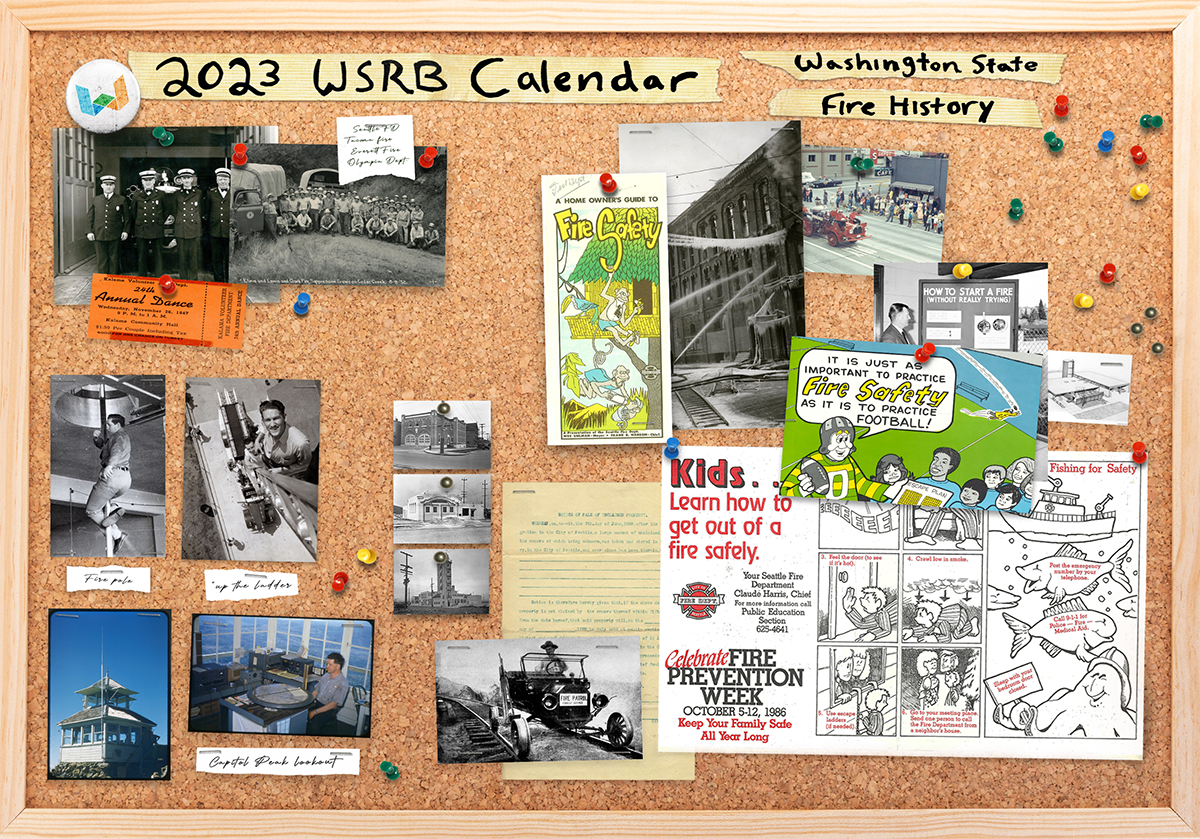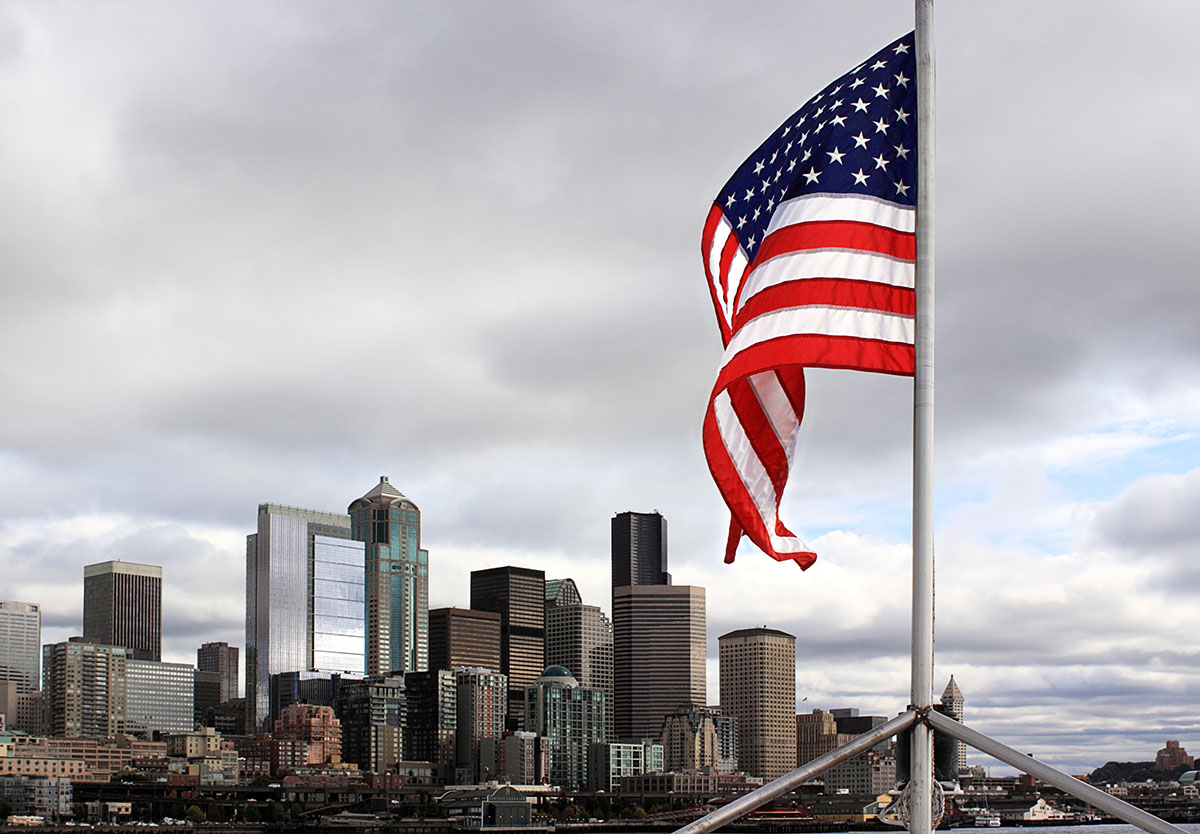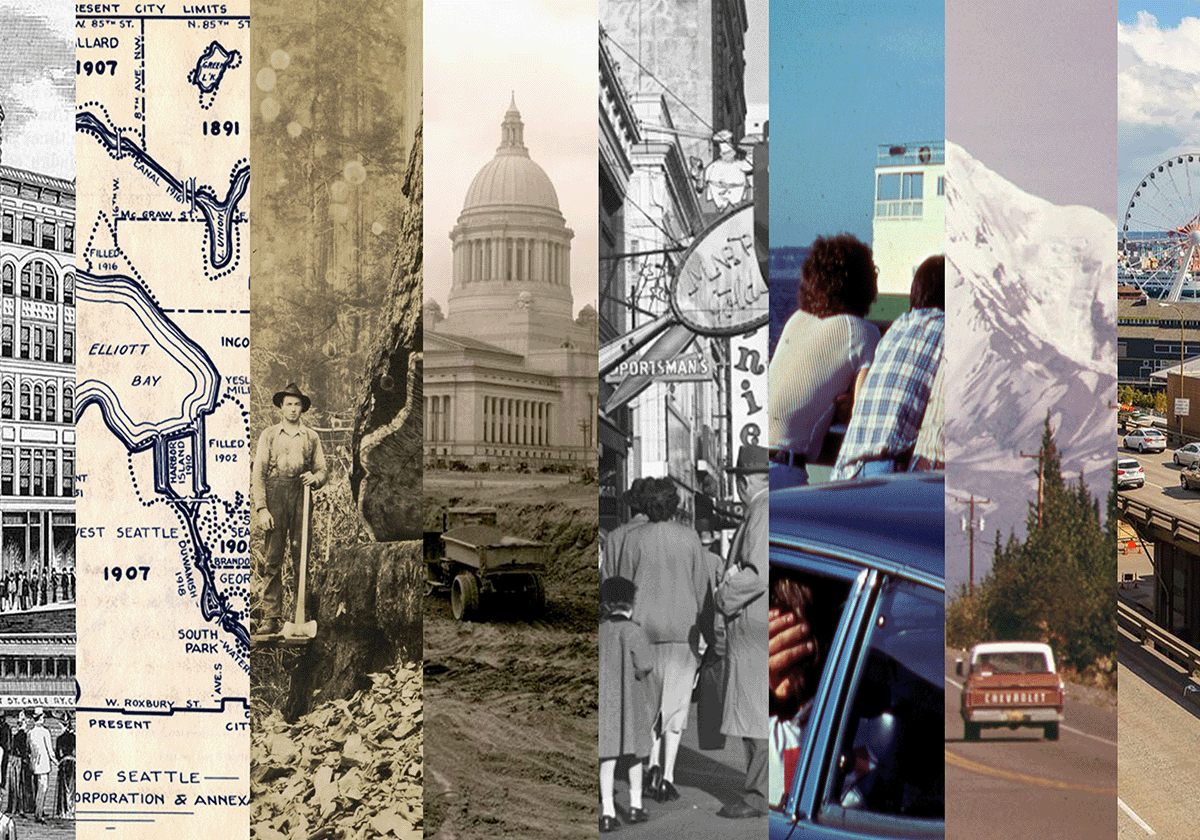Each year, we put together a WSRB-branded calendar; in the past, we've highlighted historic buildings from around Washington but this year we are doing something a little different.
Presenting the history of firefighting in Washington state, offered to you in 12 bite-sized visual history lessons. Don't have your calendar yet? Click below to download!
In addition to the calendar itself, this blog will explore in greater depth some of the histories attached to the selected photographs (NOTE: click on the images for each month to see a full-sized version). Let's dive in!
January

Men of the Spokane Fire Department, posing with their horse-drawn fire engine in
1890, just one year after the Great Fire gutted the city center.
Around 6:00 pm on August 4, 1889, a fire broke out in the center of Spokane.1
The fire blazed through the central commercial district and, due to problems at the pumping station, water pressure throughout the city was non-existent. Perfect timing. Although virtually all of Spokane’s center was razed, only one person was killed during the conflagration.
Though the cause has never been determined, theories include cooking fires, curling irons, and sparking trains. However, it very well could be that fate and destiny were playing a cruel trick; it was only two months earlier that a similar fire gutted downtown Seattle. Can’t have a major city on the western side of the state burn without also having a major city on the eastern side of the state burn, right?
Reborn from the ashes, Spokane went on to rebuild better than ever before.
February
A brand-new Mack 1000 gpm pumper, purchased by the Tacoma Fire Department
in 1947, sits parked in front of Fire Station No. 2.
First erected in 1907, Tacoma’s Fire Station No. 2 was the largest station in the city and served a growing population to the south of downtown.2
In 1933, in the throes of the Great Depression, the Washington State Emergency Relief Administration provided Tacoma with a grant to construct two new fire stations. Instead of using the grant funding to build additional stations, the city decided to put the money towards remodeling the existing Fire Station No. 2.
Giving work to previously unemployed citizens, remodeling efforts began in 1935. The design was simplified, a second story removed, walls were reinforced, and the previously brick façade was stuccoed over in the clean, modern style of Art Deco. And as a bonus for the firefighters stationed there, a handball court was constructed. Game on.
Today, Fire Station No. 2 still operates as the oldest active fire station in the city.
March

The 1920s saw innovations such as the portable water pump, used effectively to
fight wildfires. This photo was taken by famed photographer Asahel Curtis.
Asahel Curtis moved to Washington in 1888 and spent the next 53 years documenting life and landscapes throughout the Pacific Northwest, including a stint in the Yukon where he experienced the Klondike Gold Rush.3
Here are a few more famous photos taken by Curtis:

By the end of his career, he had taken tens of thousands of photographs, many of which are preserved today in historical archives around the state.
April
A man is seen here nailing up a fire safety sign for the Washington Forest Fire
Association State Forest Fire Service in 1930.
The Washington Forest Fire Association, now known as the Washington Forest Protection Association (WFPA) was first established in 1908.4
During the first 50 years of its existence, the organization took a zero-tolerance policy to fire; on their watch, fire was the enemy and was to be stopped at any cost. However, by the 1960s, a greater scientific understanding of forest management illuminated the downsides of aggressive fire protection policies, demonstrating that controlled fires were beneficial to the overall health of the forest. From this point on, rather than treating fire as something which should not and could not happen, the WFPA morphed from a fire prevention organization to a political organization, lobbying on behalf of environmental groups and landowners.
Since the 1960s, the WFPA has continued its mission of reducing the threat of forest fires. By encouraging beneficial forest management practices, including thinning small trees, clearing brush, and conducting controlled burns, the organization works year-round to keep our forests, and the people that live in and near them, safe and healthy.
May
A fire hose brigade pulls their equipment behind them during a 1915 parade in
Sprague, a small town to the southwest of Spokane.
In the days before the ubiquity of fire engines, horse and man power were used to transport equipment to the scene of a fire. In the image shown here, you can see a hose team pulling the equipment behind them. Just look at how many men it takes to drag the hose alone! Can you image how much work it was to be a firefighter back in those days?
Much of firefighting history was built completely on manual labor.5 And while firefighting today is by no means an easy profession, the efforts exerted in those early days had to have been mind-boggling.
It wasn’t until 1860 that horse-drawn steam engine apparatuses were employed; it took another 40 years for the first self-propelled steam-powered fire engines to emerge. Throughout the early decades of the 20th century, internal combustion engine apparatuses were slowly adopted, taking a lot of the effort required to transport men and gear to the site of the fire. However, it took until the mid-1920s, especially in rural outfits like that of Sprague, for fire departments to adopt modern engines.
Thank goodness for the automobile.
June
During the wildfire season of 1952, a fire lookout in
Okanogan County posing with her Osborne Firefinder.
Fire lookouts have been used for roughly 100 years in Washington state, tasked with observing fire and related weather activity.6 Located high atop mountains throughout the state’s remote forests, lookouts work long stints in isolated conditions, often lacking many modern amenities such as running water and electricity.
As monitoring of wildfire activity becomes easier through the aid of satellite imagery and other modern technologies, fire lookout towers are slowly becoming obsolete. Even so, 93 remain operational throughout Washington, down from 660 during the heyday in the 1930s, 40s, and 50s.7
And while the number of manned stations has declined in recent decades, many of the older lookouts have been rebuilt, restored, and maintained for posterity. Here is a list of some fire lookouts you can visit and even spend the night in:
National Historic Lookout Register
July
Everett Fire Department trucks taking part in the 1976
Salty Sea Days parade through downtown.
It makes sense that a town specializing in lumber and wood products could benefit from a robust fire department, right?8 Welcome to Everett. Let’s check out a few momentous events in the history of their fire department.
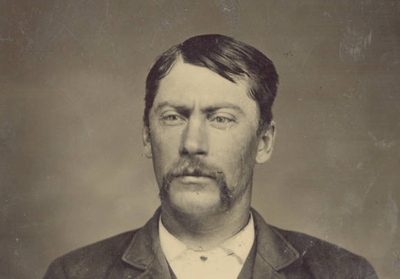 1891
1891
John A. “Jack” Bone, seen here, was the founder of the Everett volunteer fire department.
He went on to become the Chief of the official fire department and later city inspector.
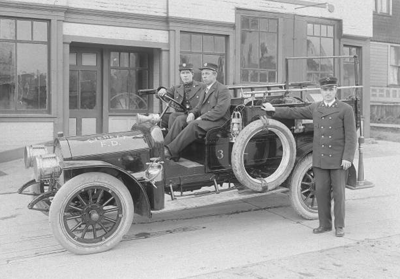 1909
1909
One of the first motorized ladder trucks in the city.
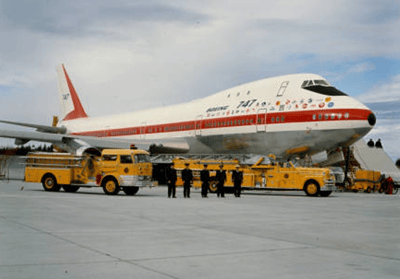 1969
1969
Firefighters and trucks are seen here in front of the world's very first Boeing 747 airplane.
August
Seattle Fire Department boats moored at Fire Station
No. 5 on Alaskan Way, seen here in 2001.
The fireboats Chief Seattle and Alki can be seen here, moored along the waterfront of Elliot Bay. Though the Chief Seattle, completed in 1984, is still in service today, the older Alki, originally constructed in 1927, has since been retired from service as of 2013.9,10
The Alki was Seattle’s third fireboat, following the Snoqualmie (originally built in 1891 but later renovated to accommodate firefighting equipment in 1909) and the Duwamish (1909), the second purpose-built firefighting vessel in US history.11,12 Following a 1947 upgrade to diesel engines, the Alki became the “third most powerful fireboat” in the world, able to pump 16,200 gallons per minute.
Before retiring the Alki, the Seattle Fire Department commissioned the Leschi, built for $12 million dollars in a shipyard in Anacortes. The new fireboat is a thoroughly modern machine, offering incredible pumping capacity, foam reserves, a telescoping crane, and a mobile command center with advanced CBRN defense systems.
Next time you’re down by the waterfront, stop by Station 5 and check out what the future of waterborne firefighting capabilities looks like.
September
A DNR-owned Kaman H-43 Huskie helitack, seen here in
1974 carrying a Sims 450-gallon water bucket
It may look a little silly, but the Kaman HH-43 Huskie, developed by the US Air Force in the 1950s, was an exceedingly practical utility helicopter that served important rescue and firefighting purposes.13 Designed as a quick response helicopter, the Huskie could be deployed at a moment’s notice, carrying with it fire suppression equipment and roughly 700 gallons of foam.
During the Vietnam War, the Huskie was operated by the Aerospace Rescue and Recovery Service out of airbases across Vietnam and Southeast Asia.14 Though the flight radius of the craft with a full tank was a meager 75 miles, additional fuel drums increased their range and allowed them to fly rescue missions deep into North Vietnam, Laos, and Cambodia.
By the end of the conflict, HH-43 crews had successfully saved more lives than any other rescue helicopter during the war. Between 1966 and 1970, crews performed 888 combat saves.
Want to learn more about the Huskie? Check out this video!
October
Photo roster of the 1922 Colfax Fire Department featuring the departments
American LaFrance pumper in the center.
America LaFrance, a now-defunct US-based vehicle manufacturer, was one of the oldest fire apparatus manufacturers in the country.15 Originally founded in 1873, their early years saw the production of hand-powered equipment and steam power fire engines. By 1907, they had begun producing motorized fire engines.
For roughly forty years, ALF produced fire engines like the one owned by the Colfax Fire Department: engine in the front, driver in the middle, equipment in the back. However, in 1947, the company introduced its 700-series engines with a “cab forward” design. For the first time, the driver was placed ahead of the engine, giving them an unimpeded forward view. This design quickly became the industry standard and continues to the present day.
November
"Sparky", the mascot of the NFPA, posing with several firefighters
from Tacoma Fire Department Station No. 6 in 1956.
For over 70 years, Sparky the Fire Dog has served as the official mascot of the National Fire Protection Association (NFPA).16 He was created in 1951 and has since become a recognizable fire safety icon by adults and children alike.
Digging around in the Seattle Archives, we came across a fantastic piece of Sparky history. Back in the 1960s, Sparky was featured in several PSAs and, accompanying him on screen, was a fantastic jingle written specifically for him. Check it out!
In recent years, his website, sparky.org, has exploded in popularity, offering kids interactive lessons and games that teach them the importance of fire safety.
December
Firefighters at Seattle Fire Department’s Station 25, located in
Capitol Hill, making the most of their 2019 snow day.
Firefighting is a challenging profession. It takes the mind and the body, requiring long hours and stressful situations.
To all the men and women who serve, here in Washington state, around the country, and around the world, we extend our gratitude; thank you for doing what you do day in and day out. Even though the job may be tough, we hope you get to spend some relaxing time together with your friends and family.
We look forward to another fantastic year of helping you to do the best work you can.
Here’s to 2023 and everything that comes with it!
[1] Wikipedia, https://en.wikipedia.org/wiki/Great_Spokane_Fire
[2] NPGallery, https://npgallery.nps.gov/NRHP/GetAsset/NRHP/86000972_text
[3] History Link, https://www.historylink.org/file/8780
[4] History Link, https://www.historylink.org/File/8800
[5] Wikipedia, https://en.wikipedia.org/wiki/History_of_firefighting
[6] Will Hite Web, http://www.willhiteweb.com/washington/fire_lookouts/history/locations_465.htm
[7] Seattle Times, https://www.seattletimes.com/life/outdoors/93-fire-lookout-towers-remain-in-wa-heres-what-its-like-working-and-living-in-one
[8] Herald Net, https://www.heraldnet.com/news/a-look-at-everett-history-through-firefighting/
[9] Wikipedia, https://en.wikipedia.org/wiki/Chief_Seattle_(fireboat)
[10] Wikipedia, https://en.wikipedia.org/wiki/Alki_(boat)
[11] Wikipedia, https://en.wikipedia.org/wiki/Snoqualmie_(fireboat)
[12] Wikipedia, https://en.wikipedia.org/wiki/Duwamish_(fireboat)
[13] Wikipedia, https://en.wikipedia.org/wiki/Kaman_HH-43_Huskie
[14] Wikipedia, https://en.wikipedia.org/wiki/United_States_Air_Force_Combat_Rescue_School
[15] Wikipedia, https://en.wikipedia.org/wiki/American_LaFrance




